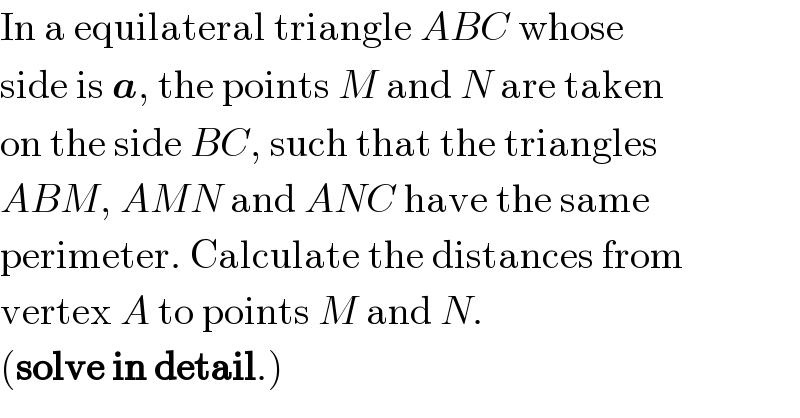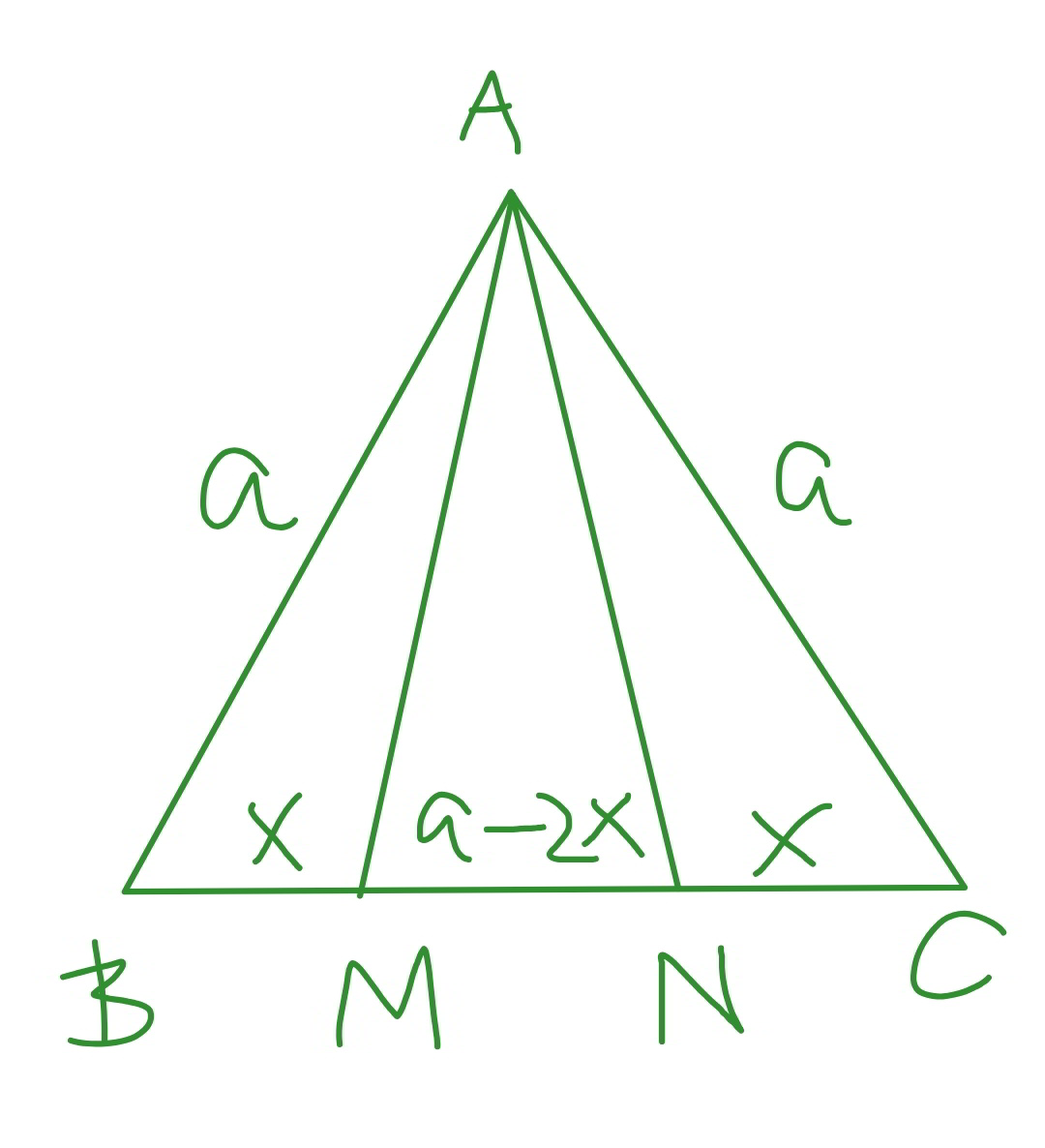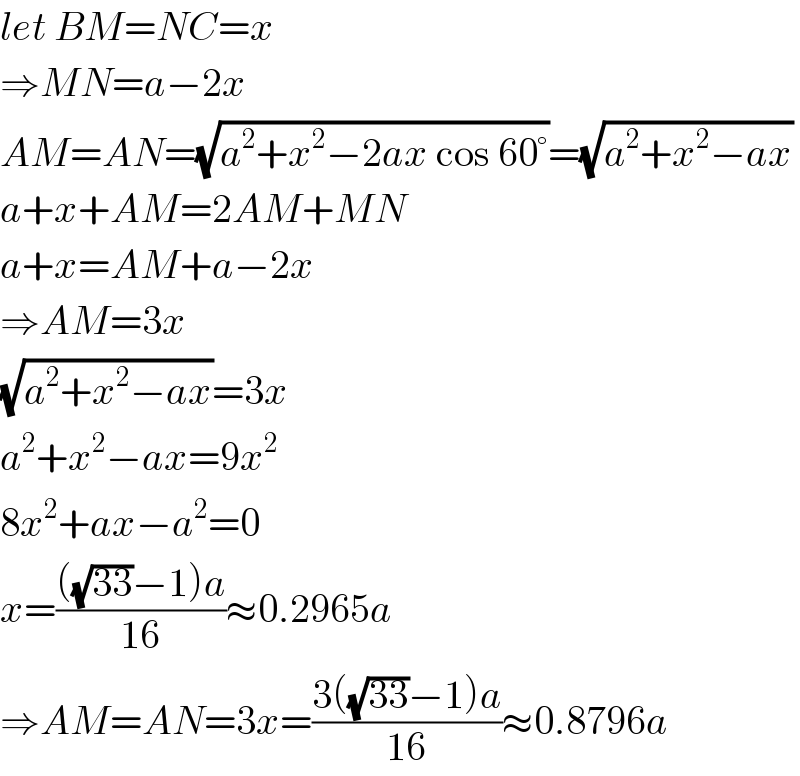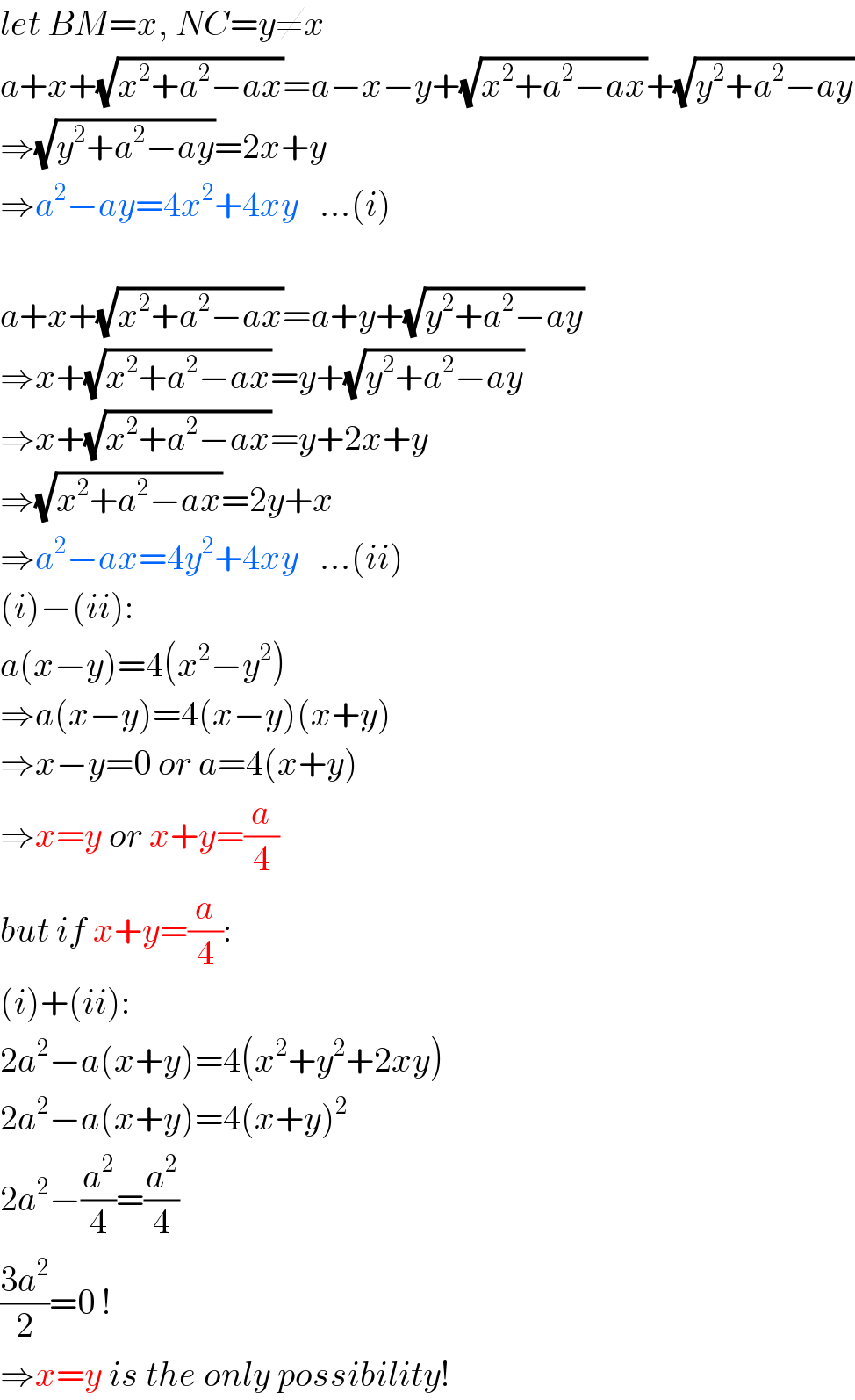Question Number 68664 by Maclaurin Stickker last updated on 14/Sep/19

$$\mathrm{In}\:\mathrm{a}\:\mathrm{equilateral}\:\mathrm{triangle}\:{ABC}\:\mathrm{whose} \\ $$$$\mathrm{side}\:\mathrm{is}\:\boldsymbol{{a}},\:\mathrm{the}\:\mathrm{points}\:{M}\:\mathrm{and}\:{N}\:\mathrm{are}\:\mathrm{taken} \\ $$$$\mathrm{on}\:\mathrm{the}\:\mathrm{side}\:{BC},\:\mathrm{such}\:\mathrm{that}\:\mathrm{the}\:\mathrm{triangles} \\ $$$${ABM},\:{AMN}\:\mathrm{and}\:{ANC}\:\mathrm{have}\:\mathrm{the}\:\mathrm{same}\: \\ $$$$\mathrm{perimeter}.\:\mathrm{Calculate}\:\mathrm{the}\:\mathrm{distances}\:\mathrm{from} \\ $$$$\mathrm{vertex}\:{A}\:\mathrm{to}\:\mathrm{points}\:{M}\:\mathrm{and}\:{N}. \\ $$$$\left(\boldsymbol{\mathrm{solve}}\:\boldsymbol{\mathrm{in}}\:\boldsymbol{\mathrm{detail}}.\right) \\ $$
Answered by mr W last updated on 14/Sep/19

Commented by mr W last updated on 14/Sep/19

$${let}\:{BM}={NC}={x} \\ $$$$\Rightarrow{MN}={a}−\mathrm{2}{x} \\ $$$${AM}={AN}=\sqrt{{a}^{\mathrm{2}} +{x}^{\mathrm{2}} −\mathrm{2}{ax}\:\mathrm{cos}\:\mathrm{60}°}=\sqrt{{a}^{\mathrm{2}} +{x}^{\mathrm{2}} −{ax}} \\ $$$${a}+{x}+{AM}=\mathrm{2}{AM}+{MN} \\ $$$${a}+{x}={AM}+{a}−\mathrm{2}{x} \\ $$$$\Rightarrow{AM}=\mathrm{3}{x} \\ $$$$\sqrt{{a}^{\mathrm{2}} +{x}^{\mathrm{2}} −{ax}}=\mathrm{3}{x} \\ $$$${a}^{\mathrm{2}} +{x}^{\mathrm{2}} −{ax}=\mathrm{9}{x}^{\mathrm{2}} \\ $$$$\mathrm{8}{x}^{\mathrm{2}} +{ax}−{a}^{\mathrm{2}} =\mathrm{0} \\ $$$${x}=\frac{\left(\sqrt{\mathrm{33}}−\mathrm{1}\right){a}}{\mathrm{16}}\approx\mathrm{0}.\mathrm{2965}{a} \\ $$$$\Rightarrow{AM}={AN}=\mathrm{3}{x}=\frac{\mathrm{3}\left(\sqrt{\mathrm{33}}−\mathrm{1}\right){a}}{\mathrm{16}}\approx\mathrm{0}.\mathrm{8796}{a} \\ $$
Commented by Rasheed.Sindhi last updated on 15/Sep/19

$$\boldsymbol{\mathrm{Sir}},\:\mathrm{why}\:\mathrm{have}\:\mathrm{you}\:\mathrm{assumed}\:{BM}={NC}? \\ $$
Commented by mr W last updated on 15/Sep/19

$${the}\:{assumption}\:{is}\:{based}\:{on}\:{symmetry}. \\ $$$${certainly}\:{it}\:{can}\:{also}\:\:{be}\:{proved}\:{that} \\ $$$${BM}\:{must}\:{be}\:{equal}\:{to}\:{NC}. \\ $$
Commented by mr W last updated on 15/Sep/19

$${let}\:{BM}={x},\:{NC}={y}\neq{x} \\ $$$${a}+{x}+\sqrt{{x}^{\mathrm{2}} +{a}^{\mathrm{2}} −{ax}}={a}−{x}−{y}+\sqrt{{x}^{\mathrm{2}} +{a}^{\mathrm{2}} −{ax}}+\sqrt{{y}^{\mathrm{2}} +{a}^{\mathrm{2}} −{ay}} \\ $$$$\Rightarrow\sqrt{{y}^{\mathrm{2}} +{a}^{\mathrm{2}} −{ay}}=\mathrm{2}{x}+{y} \\ $$$$\Rightarrow{a}^{\mathrm{2}} −{ay}=\mathrm{4}{x}^{\mathrm{2}} +\mathrm{4}{xy}\:\:\:…\left({i}\right) \\ $$$$ \\ $$$${a}+{x}+\sqrt{{x}^{\mathrm{2}} +{a}^{\mathrm{2}} −{ax}}={a}+{y}+\sqrt{{y}^{\mathrm{2}} +{a}^{\mathrm{2}} −{ay}} \\ $$$$\Rightarrow{x}+\sqrt{{x}^{\mathrm{2}} +{a}^{\mathrm{2}} −{ax}}={y}+\sqrt{{y}^{\mathrm{2}} +{a}^{\mathrm{2}} −{ay}} \\ $$$$\Rightarrow{x}+\sqrt{{x}^{\mathrm{2}} +{a}^{\mathrm{2}} −{ax}}={y}+\mathrm{2}{x}+{y} \\ $$$$\Rightarrow\sqrt{{x}^{\mathrm{2}} +{a}^{\mathrm{2}} −{ax}}=\mathrm{2}{y}+{x} \\ $$$$\Rightarrow{a}^{\mathrm{2}} −{ax}=\mathrm{4}{y}^{\mathrm{2}} +\mathrm{4}{xy}\:\:\:…\left({ii}\right) \\ $$$$\left({i}\right)−\left({ii}\right): \\ $$$${a}\left({x}−{y}\right)=\mathrm{4}\left({x}^{\mathrm{2}} −{y}^{\mathrm{2}} \right) \\ $$$$\Rightarrow{a}\left({x}−{y}\right)=\mathrm{4}\left({x}−{y}\right)\left({x}+{y}\right) \\ $$$$\Rightarrow{x}−{y}=\mathrm{0}\:{or}\:{a}=\mathrm{4}\left({x}+{y}\right) \\ $$$$\Rightarrow{x}={y}\:{or}\:{x}+{y}=\frac{{a}}{\mathrm{4}} \\ $$$${but}\:{if}\:{x}+{y}=\frac{{a}}{\mathrm{4}}: \\ $$$$\left({i}\right)+\left({ii}\right): \\ $$$$\mathrm{2}{a}^{\mathrm{2}} −{a}\left({x}+{y}\right)=\mathrm{4}\left({x}^{\mathrm{2}} +{y}^{\mathrm{2}} +\mathrm{2}{xy}\right) \\ $$$$\mathrm{2}{a}^{\mathrm{2}} −{a}\left({x}+{y}\right)=\mathrm{4}\left({x}+{y}\right)^{\mathrm{2}} \\ $$$$\mathrm{2}{a}^{\mathrm{2}} −\frac{{a}^{\mathrm{2}} }{\mathrm{4}}=\frac{{a}^{\mathrm{2}} }{\mathrm{4}} \\ $$$$\frac{\mathrm{3}{a}^{\mathrm{2}} }{\mathrm{2}}=\mathrm{0}\:! \\ $$$$\Rightarrow{x}={y}\:{is}\:{the}\:{only}\:{possibility}! \\ $$
Commented by Rasheed.Sindhi last updated on 15/Sep/19

$$\mathcal{T}{h}\alpha{n}\mathcal{X}\:{a}\:{lot}\:{sir}.\:{You}'\mathrm{re}\:{very}\:{deep} \\ $$$${in}\:{geometry}\:{also}! \\ $$
